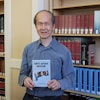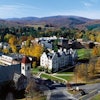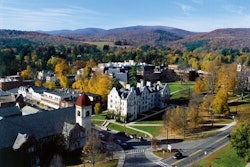Despite feverish efforts by presidential candidates to grab voters’ attention, they, along with public opinion polls and mainstream news coverage, have largely ignored Asian Americans so far, several political scientists say.
“It’s kind of annoying,” says Dr. Andrew Aoki, associate professor of political science at Augsburg College. “It gives Asian Americans a feeling of being overlooked.”
It’s possible the candidates will improve their outreach as the November’s election nears, but Aoki and other scholars aren’t sure whether it would be noticed much.
“You rarely see an acknowledgement of Asians in national campaigns,” says Dr. Natalie Masuoka, an assistant professor of political science at Tufts University.
Multiple, complex reasons have resulted in the near-invisibility of Asian Americans in the campaign, these scholars say.
Nationally, Asian Americans compose about 4 percent of the population. While they are most numerous in states such as Hawaii and California, their ranks are rapidly growing in Nevada, Oregon, Minnesota, New Jersey and elsewhere. Yet this growth across many states, rather than just one or two, leads to perceptions that they don’t form enough of a voting bloc in each state to justify a candidate’s time.
After all, a presidential election is based on winning the majority of votes in each state, not necessarily the popular vote nationally.
Furthermore, it’s tough to convince candidates that Asians will even bother to cast ballots when considering their turnout during the 2004 election, says Dr. Karthick Ramakrishnan, assistant professor of political science at the University of California, Riverside. He cites the Current Population Survey, which shows that only 55 percent of Asian Americans voted in that election, versus 72 percent of Blacks and 74 percent of Whites. Among Hispanics, only 55 percent voted in 2004, but Hispanics outnumber Asians in the general population by more than 3-to-1, so politicians have a bigger pool of potential supporters in them. Ironically, surveys indicate that Asians generally earn higher incomes and reach higher levels of educational attainment than other racial demographics, Ramakrishnan says. These characteristics would typically make them high-propensity voters.
Voter turnout among Asians is low partly because so little campaign outreach targets them, Ramakrishnan says, describing it as an example of the proverbial chicken-egg syndrome.
Language diversity remains a challenge too. Unlike U.S. Hispanics who overwhelmingly share Spanish as a commonality, Asian Americans have languages and dialects as different and distinct as Vietnamese, Korean, Tagalog, Mandarin, Gujarati and Urdu — to name only a few.
“Add it together and candidates don’t believe it’s cost-effective to target Asians,” Ramakrishnan says. “Asians don’t have extensive voting histories, so a candidate has no information to start with. And candidates don’t want to risk mobilizing voters who will vote for their opponents.”
Similarly, public opinion polls in election politics rarely include Asian Americans because organizers don’t believe it’s worth the cost of providing so many different language interpreters for so few people being polled, says Aoki. He adds that the methodology of polling also has inherent drawbacks that work against Asian inclusion.
For instance, if a national poll calls for 600 respondents, that would call for 10 to 25 Asians to reflect their share of the general population. However, a sample of less than 30 in such a poll is too little from which to draw reliable conclusions, Aoki says. So Asians would be excluded.
“I understand the methodology problem, but this just adds to the invisibility problem for Asians,” Aoki says.
Ramakrishnan adds: “While there are defensible reasons for these decisions, there’s a larger cost to American democracy. Considering the growth of Asian American communities, it’s problematic for political parties and organizations not to invest in them. Hopefully, community organizations and foundations can play a role in changing that.’
Neither he, Aoki nor Masuoka were aware Norman Mineta, a cabinet secretary under President Bill Clinton, is endorsing Barack Obama rather than Hillary Clinton for the Democratic nomination until a reporter recently broached the subject. A Japanese American, Mineta also was a U.S. representative for 20 years. The airport in San Jose, Calif., has been re-named for him.
The three scholars criticized the mainstream news media for their relatively scant publicity of Mineta’s endorsement, especially when compared to the widespread coverage of Bill Richardson’s endorsement of Obama over Clinton. A Mexican American, Richardson was a cabinet secretary under Bill Clinton and currently is governor of New Mexico.
The trickle of coverage involving Asian Americans this election season so far, Ramakrishnan says, has been reporters doing occasional man-on-the-street interviews in local Chinatowns about voter choices. “It reinforces false stereotypes that all Chinese, all Asians, live in Chinatown,” he says.
Masuoka has noticed more mentions of and references to Asian Americans in speeches by Obama as well as Clinton since the February “Super Tuesday” primaries in which Clinton not only defeated Obama in California, but also claimed Asian American votes in that state by a 3-to-1 margin.
“That was a positive turn that did a lot for Asian American politics,” says Masuoka, who’s currently a visiting assistant professor at Duke University’s Center for the Study of Race, Ethnicity and Gender in Social Sciences. “Based on how both candidates reacted, they clearly saw how Asians can make a difference.”
Aoki finds impressive the microtargeting and other strategies of Asian American political activists to try boosting voter turnout this fall. “They’re sophisticated strategies that political campaigns and parties understand,” he says. “Now, the parties need to do their part to bring out Asians.”
Click here to post and read comments
© Copyright 2005 by DiverseEducation.com















